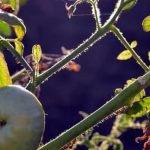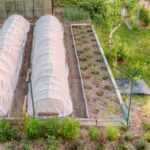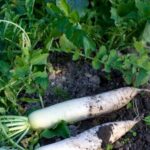Nutsedge is a persistent and troublesome weed that can quickly take over your beloved vegetable garden. Learning how to kill nutsedge in vegetable gardens is essential for maintaining a healthy and thriving growing space. From identifying the signs of a nutsedge infestation to implementing effective control methods, gardeners need to be equipped with the knowledge and tools to combat this invasive plant.
Nutsedge not only competes with vegetables for nutrients, water, and sunlight but also releases chemicals that inhibit the growth of other plants in its vicinity. This makes it essential to understand the impact of nutsedge on vegetable gardens and why it’s such a challenging weed to manage.
In this article, we will explore different control methods for tackling nutsedge, including cultural, mechanical, chemical, and organic approaches. By understanding how to identify, prevent, and eradicate nutsedge in your vegetable garden, you can achieve a nutsedge-free growing space and enjoy bountiful harvests without the interference of this problematic weed.
Identifying Nutsedge in Your Vegetable Garden
Nutsedge, also known as nutgrass, can be a troublesome weed in vegetable gardens. Identifying this invasive plant is the first step in effectively managing its growth and preventing it from taking over your garden.
Distinguishing Nutsedge From Other Garden Weeds
One of the key characteristics of nutsedge is its triangular stem, which sets it apart from other common garden weeds. This stem can be felt by running your fingers along the length of the plant. Additionally, nutsedge typically has three long, slender leaves that emerge from the base of the plant. These features make it easy to distinguish nutsedge from other plants in your vegetable garden.
Signs and Symptoms of a Nutsedge Infestation
When left unchecked, a nutsedge infestation can quickly spread and overtake a garden bed. Signs of nutsedge infestation include patches of rapidly growing, grass-like plants that may appear lighter green in color compared to surrounding vegetation. Additionally, nutsedge produces small tubers or nutlets underground, which can further contribute to its ability to spread rapidly. It’s important to keep an eye out for these signs and symptoms in order to catch a nutsedge infestation early on.
By learning how to properly identify nutsedge in your vegetable garden, you can take proactive steps towards managing its growth and preventing it from becoming a larger issue. Whether through cultural, mechanical, chemical, or organic control methods, developing an understanding of nutsedge is crucial for maintaining a healthy and thriving vegetable garden.
Cultural Control Methods for Nutsedge
Nutsedge can be a persistent and challenging weed to manage in vegetable gardens, often posing a threat to the health and productivity of garden crops. While there are various control methods available, cultural control tactics can be highly effective in reducing nutsedge populations and preventing its reinfestation. By implementing proper cultural practices, gardeners can create an environment that is less conducive to nutsedge growth.
Implementing Proper Irrigation and Drainage
One of the key cultural control methods for managing nutsedge in vegetable gardens is to ensure proper irrigation and drainage. Nutsedge thrives in moist soil conditions, so it is essential to avoid overwatering. Implementing a targeted watering schedule that provides adequate moisture to garden crops while avoiding waterlogged soil can help discourage nutsedge growth. Additionally, improving drainage in the garden by amending soil with organic matter or creating raised beds can also deter nutsedge infestations.
Mulching and Soil Management Techniques
Mulching serves as an effective cultural control method for suppressing nutsedge growth in vegetable gardens. Applying a layer of organic mulch, such as wood chips or straw, helps to smother existing nutsedge plants while also preventing new ones from emerging. Furthermore, practicing good soil management techniques, such as regular tilling and cultivation, can disrupt nutsedge rhizomes and tubers within the soil, hindering their ability to sprout and spread.
Overall, incorporating these cultural control methods into the gardening routine can greatly contribute to the successful management of nutsedge in vegetable gardens. By creating unfavorable growing conditions for nutsedge and actively discouraging its proliferation through proper irrigation, drainage, mulching, and soil management techniques, gardeners can effectively reduce infestations and maintain a healthy, nutgrass-free garden environment.
Mechanical Control Methods for Nutsedge
Nutsedge is a persistent and invasive weed that can quickly take over vegetable gardens if left unchecked. While chemical control methods are effective, many gardeners prefer to use mechanical control methods to avoid the use of herbicides. Here are some effective mechanical control methods for managing nutsedge in your vegetable garden:
- Hand weeding: One of the most basic and effective ways to control nutsedge is through hand weeding. Use a handheld weeder or garden trowel to carefully uproot individual nutlets and tubers from the soil. Be sure to remove as much of the underground plant parts as possible to prevent regrowth.
- Garden tools and equipment: For larger infestations of nutsedge, consider using garden tools such as a hoe or cultivator to help remove nutsedge from the soil. These tools can help loosen the soil and make it easier to pull out nutsedge plants by their roots.
- Barrier methods: Another effective mechanical control method involves creating barriers that prevent nutsedge from spreading further. Consider using landscape fabric or heavy mulch to smother existing nutsedge plants and prevent new ones from emerging.
By incorporating these mechanical control methods into your regular gardening routine, you can effectively manage and reduce the presence of nutsedge in your vegetable garden without relying on chemical herbicides. Remember that consistent maintenance and vigilance are key to keeping nutsedge at bay in the long term.
Chemical Control Methods for Nutsedge
When cultural and mechanical methods have not been effective in controlling nutsedge in your vegetable garden, chemical control methods can be considered. Here are some key points to consider when implementing chemical control methods:
- Overview of herbicides: There are specific herbicides formulated to target and eliminate nutsedge in vegetable gardens. Look for herbicides that contain active ingredients such as sulfosulfuron, halosulfuron, or imazosulfuron, which are effective against nutsedge.
- Application for nutsedge control: It is important to carefully follow the instructions provided on the herbicide label. Apply the herbicide when the nutsedge plants are actively growing and have developed a sufficient leaf area. This will ensure that the herbicide is absorbed effectively by the plants.
- Tips for safely and effectively using herbicides: When using herbicides, it is crucial to wear protective clothing, including gloves, long-sleeved shirts, long pants, closed-toe shoes, and eye protection. Additionally, it is important to apply the herbicide on a calm day to prevent drift onto desirable plants.
It is essential to exercise caution and adhere to safety guidelines when using chemical control methods for nutsedge in vegetable gardens. Always read and follow the instructions provided by the manufacturer to ensure effective and safe application of herbicides for nutsedge control.
Finally, always remember that chemical control should only be used as a last resort after trying cultural and mechanical methods of control first. Implementing an integrated approach that combines different control methods can help achieve better long-term results in managing nutsedge in vegetable gardens.
Organic Control Methods for Nutsedge
The struggle to maintain a nutgrass-free vegetable garden can be a challenging task for many gardeners. Fortunately, there are several organic methods that can be employed to effectively combat nutsedge and prevent its reinfestation. These natural approaches can help ensure a healthy and thriving vegetable garden without the need for chemical herbicides.
One effective organic method for controlling nutsedge is through the use of homemade remedies and natural barriers. This approach involves the use of natural substances or mixtures that can deter nutsedge growth without posing harm to other plants or the environment. For example, creating a mulch barrier using materials such as cardboard, newspapers, or thick layers of straw can prevent nutsedge from sprouting and eventually minimize its population in the garden.
Another organic strategy is soil solarization, which involves covering the infested area with clear plastic sheeting during hot summer months. The heat generated under the plastic helps to kill nutsedge tubers and seeds by raising soil temperatures to levels that are lethal to weed seeds and tubers. It’s an eco-friendly method that effectively reduces nutsedge populations without relying on chemical treatments.
In addition to homemade remedies and natural barriers, promoting strong competition among desirable plants is also an effective organic control method for nutsedge. Planting densely or using ground covers can help shade out nutsedge and minimize its ability to establish itself in the garden. By incorporating these organic control methods into your gardening practices, you can successfully manage nutsedge and maintain a thriving vegetable garden without compromising on environmental safety.
| Organic Control Methods | Benefits |
|---|---|
| Homemade Remedies and Natural Barriers | Deters nutsedge growth without harming other plants. |
| Soil Solarization | Kills nutsedge tubers and seeds using heat generated under clear plastic sheeting. |
| Promoting Strong Competition Among Desirable Plants | Minimizes establishment of nutsedge in the garden by shading it out. |
Preventing Nutsedge Reinfestation in Vegetable Gardens
Once you have successfully eradicated nutsedge from your vegetable garden, it is crucial to take proactive measures to prevent its reinfestation. Gardeners must be diligent in implementing preventative strategies to maintain a nutsedge-free environment and ensure the health and productivity of their vegetable plants.
One effective method to prevent nutsedge reinfestation is through the use of pre-emergent herbicides. These products are designed to inhibit the germination and growth of nutsedge seeds, effectively reducing the likelihood of new infestations. It is important to carefully follow the application instructions on the herbicide label and apply it at the appropriate time to achieve maximum effectiveness.
In addition to utilizing herbicides, regular cultivation and proper soil management can also play a significant role in preventing nutsedge reinfestation. By regularly turning over the soil and properly managing irrigation and drainage, gardeners can create an environment that is less conducive to nutsedge growth. Mulching with materials such as wood chips or landscape fabric can also serve as a protective barrier against nutlet sprouting, further reducing the risk of reinfestation.
Ultimately, maintaining a vigilant approach to monitoring your vegetable garden for any signs of nutsedge regrowth is essential. By promptly addressing any emerging nutsedge plants through manual removal or targeted herbicide application, gardeners can effectively minimize the risk of reinfestation and enjoy a thriving, nutsege-free vegetable garden for seasons to come.
| Prevention Method | Description |
|---|---|
| Pre-Emergent Herbicides | Inhibits germination and growth of nutsedge seeds |
| Proper Soil Management | Regular cultivation and mulching with protective barriers |
| Vigilant Monitoring | Promptly addressing any signs of nutsedge regrowth through manual removal or targeted herbicide application. |
Conclusion
In conclusion, effectively managing and controlling nutsedge in vegetable gardens is a challenging but achievable task. By implementing a combination of cultural, mechanical, chemical, and organic control methods, gardeners can significantly reduce nutsedge populations and create a more hospitable environment for their vegetables to thrive. It’s important to remember that consistent maintenance and vigilance are essential in preventing reinfestation and achieving long-term success.
One key takeaway is the significance of proper irrigation and soil management in discouraging nutsedge growth. By addressing these foundational aspects of gardening, gardeners can create an environment that is less conducive to nutsedge proliferation. Additionally, the diligent use of mechanical methods such as hand weeding, along with the strategic application of herbicides when necessary, can further contribute to effective nutsedge control.
Ultimately, armed with the knowledge and tools provided in this article, gardeners can approach nutgrass infestations with confidence and determination. With a proactive approach to prevention and a well-rounded strategy for control, it is indeed possible to achieve nutsedge-free vegetable gardens. By staying informed and actively implementing these control methods, gardeners can reclaim their vegetable patches from the clutches of pervasive nutsedge.
Frequently Asked Questions
How Do I Get Rid of Nutsedge in My Vegetable Garden?
One way to get rid of nutsedge in your vegetable garden is to manually remove the plants by digging up the entire plant, including the underground tubers. This can be a labor-intensive process but is effective in controlling nutsedge. Mulching with organic materials can also help to suppress nutsedge growth by preventing light from reaching the soil.
How Do You Kill Nutsedge Without Killing Plants?
Killing nutsedge without harming other plants can be challenging, but using herbicides specifically labeled for nutsedge control can be effective. Products containing active ingredients such as sulfentrazone or halosulfuron are selective and target nutsedge without harming desirable plants when used according to label instructions.
Spot-treating affected areas rather than broadcasting herbicides across the entire garden can help minimize damage to other plants.
Can I Use Sedgehammer in Vegetable Garden?
Sedgehammer, a herbicide containing the active ingredient halosulfuron-methyl, is labeled for use in vegetable gardens and specifically targets nutsedge without harming other plants when applied properly. It is important to carefully read and follow all label instructions before using any herbicide in your vegetable garden, including Sedgehammer.
Applying the product at the correct time and following recommended application rates will help ensure its effectiveness and safety for surrounding plants.

If you’re looking to get into vegetable gardening, or are just looking for some tips on how to make your current garden better, then you’ve come to the right place! My name is Ethel and I have been gardening for years. In this blog, I’m going to share with you some of my best tips on how to create a successful vegetable garden.





